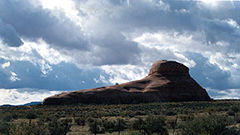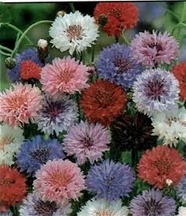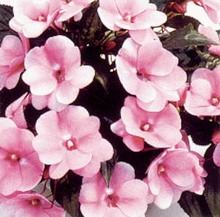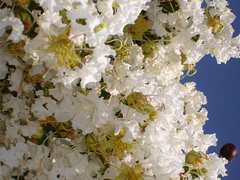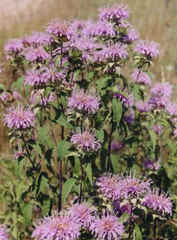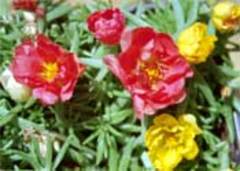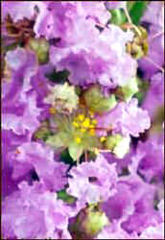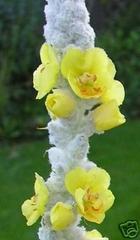Page Four
Page four of flowers, herbs and trees
Scarlet Flax: This is a perfect addition to your meadow or mass planting of this lovely flower that blooms last only one day but this is rarely noticed for the long bloom time. Sow in fall or early spring and this flower will bloom for long periods of time, and reseeds readily. Prefers a drier lighter, more gravelly soil. Doesn't tolerate boggy conditions in summer or winter. Doesn't like to be transplanted
Bachelor Button Polka Dot also known as Cornflowers.
A mixture of red, rose, blue, and lavender shades. Compact plants are 16" tall and flower more profusely than taller varieties. This is a annual plant, but it will self sow so you can enjoy the beauty of the flowers each year. It also likes full sun, so this makes this plant addition to a full sun flower garden. Bloom time is mid summer, late summer and early fall.
This plant is attractive to bees, butterflies and/or birds
Average Water Needs; Water regularly; do not overwater
Self-sows freely; deadhead if you do not want volunteer seedlings next season
Touch Me Not
Touch Me Nots (Salmon Colored) (Impatiens Balsamina) also called called Balsam, Sultana, Snap Weed, Jewel Weed, Busy Lizzy, Patient Lucy, Patience Plant or Zanzibar Balsam
Balsam grows best in full sun to shade on well-drained but moist soils, and should be spaced 12 to 14 inches apart. Plants will need a mostly shaded area in USDA hardiness zones 8 and 9 during the summer. Balsam grows poorly in USDA hardiness zones 10 and 11 during the summer unless placed in total shade. Balsams develop good root systems and transplant well, but may wilt for a day or two after transplanting. Even large plants can be successfully moved if they are watered frequently after being relocated. For large single flowers spikes, do not stop, merely remove side shoots and first formed flowers. For neater compact bushes pinch out the growing point when 3" tall
White Crape Mrytle Tree
Crape Myrtles are excellent specimen trees, as well as natural privacy barriers. Many customers choose to line their driveways with this stunning tree.
Others use them as attractive focal points at the corners of their foundation plantings. Also an exceptional choice to plant in groupings at the corners of your property.
Wild Bergamot
Double Moss Roses (Portulaca)
Choose moss rose if you need a plant that flowers where it's hot and dry. This annual's flowers - bright reds, oranges, yellows, purples and pinks - glow atop green, succulent leaves. Moss rose grows 4- to 8-inches tall and spreads up to 2 feet, making it a great groundcover.
Moss rose thrives in strawberry jars, those clay pots with several pockets for planting. It's difficult to keep other plants well watered in a strawberry pot, but moss rose is suited to the dry conditions.
These tough plants need excellent drainage, so they're also a good choice for sandy soils and slopes.
They make wonderful hanging baskets and a wonderful touch of color to your porch.
Moss rose is tough only as long as it has plenty of sun. It needs at least 6 to 8 hours of full, direct sunlight a day.
Sample Photo 6
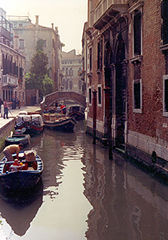
Red Crape Mrytle
The crape myrtle is valued mainly for its long period of striking summer flowers. Large clusters of red flowers appear on the tips of new branches beginning in early summer and continue into fall.
Purple Crape Mrytle Tree
The deciduous crape myrtle is among the longest blooming trees in existence with flowering periods lasting from 60-120 days. Crapes come in heights as short as 18 in (46 cm) and as tall as 40 ft (12 m). Leaves are alternate and smooth, but leaf size depends on variety. Flowers are borne in summer in big showy clusters and come in white and many shades of pink, purple, lavender and red. The fruits that follow are brown or black. When mature they dry and split releasing disk shaped seeds. Depending on variety, crapes grow as large shrubs or as trees that may be either upright or spreading. Large varieties are very fast growing and can put on several feet in a single growing season. Many types have interesting bark that exfoliates in thin flakes exposing lovely cinnamon or gray inner bark. Crapes tend to produce many suckers that should be removed as they appear if you want to maintain them as trees with distinct trunks. They are enthusiastic reseeders so you may find yourself pulling up baby crapes throughout the summer.
'Polar Summer', Mullein
'Mullein' or 'Turkish Mullein' or 'Silver Mullein' (Ver-BAS-cum: bom-by-SIF-er-um) SCROPHULARIACEAE.
Plants grow a 60-72 inch tall spike of flowers the second year. The first year they have large silver white colored -wholly textured leaves that lay low to the ground. Plants stand out in the landscape with their white powdered wooly leaves and stems topped off with soft medium yellow colored flowers over a few weeks in mid summer. The tall spires of flowers add some height interest to the garden and look real nice on a bank. Will flower June-August. For the most part plants act as biennials but are really monocarpic, and if one removes the flowering stems before flowering plants will live many years and produce wide clumps of very attractive silver colored leaves.
Yellow Tansy
A perennial herb from Europe.
Has pinnate, toothed, mid-dark green, scented (not particularly pleasent) leaflets. Bears small flat heads tightly packed with tiny yellow flowers which have no ray petals.
Flowers July-October.
Likes a well drained soil in full sun, will self seed everywhere when happy.
Do not use Tansy when pregnant. Tansy is a herb to be used in moderation only as it can be toxic in large doses. It may also irritate sensetive skins.
The leaves were once used to preserve corpses from corruption. It was used as a strewing herb in public areas as a form of disinfectant and insect repellent. It deters flies and a bunch of flowers and leaves hung up in a room will keep them away (will keep most things away including any visitors with a sense of smell if too much is used). Fleas also dislike Tansy smell and can be rubbed on a dogs coat to repel them.
It has a culinary use, bearing in mind not to use much of it, in salads, eggs, some cakes and puddings. It was also used as a digestive aid in very low amounts.
Tansy's medicinal uses, in times past, was to rid stomach worms from children, treat jaundice, hysteria (it has stimulant properties), nervous conditions, as a rub on varicose veins, muscle sprains and rheumatic joints. It was also used to treat epilepsy but it can cause a fit as well as alleviate them.
The leaves are full of potassium and a valuable addition to the compost heap, this is good because if you grow Tansy you are going to have a lot of it.
Fox Glove
Foxglove is a bienneial plant with soft, hairy, toothed, ovate and lance-shaped leaves in a basal rosette. The life span of the plant is 2 seasons. The first year growth remains in a basal rosette of leaves. Second year growth produces flowering stems, 3 -6 feet in height. Flower spikes have purple to white spotted thimble-like flowers which hang down and last about six days. The earliest known name for this plant is the Anglo-Saxon "foxes glofa" (the glove of the fox). It derives its name from the flowers which resemble the fingers of a glove and possibly from a northern legend that bad fairies gave the blossoms to the fox to put on his toes, so that he might soften his tread while he hunted for prey. First year growth has been mistaken for Comfrey (Symphitum officinale) with fatal results. Although, ingestion of this plant can be fatal at any time during the life of the plant, it is most toxic just before the seeds ripen. The upper leaves of the stem are also more toxic than the lower leaves.
Sample Photo 12
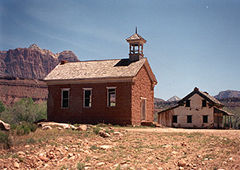
Sample Photo 13
